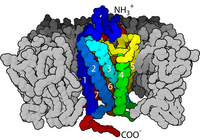
Cell surface expression of human RP105 depends on N‐glycosylation of MD‐1
Sign Up to like & getrecommendations! Published in 2022 at "FEBS Letters"
DOI: 10.1002/1873-3468.14452
Abstract: For its cell surface expression, radioprotective 105 (RP105) – an orphan Toll‐like receptor – must form a complex with a soluble glycoprotein called myeloid differentiation 1 (MD‐1). The number of RP105‐negative cells is significantly increased… read more here.
Keywords: cell surface; surface expression; rp105;

Carbon monoxide controls microglial erythrophagocytosis by regulating CD36 surface expression to reduce the severity of hemorrhagic injury
Sign Up to like & getrecommendations! Published in 2020 at "Glia"
DOI: 10.1002/glia.23864
Abstract: Microglial erythrophagocytosis is crucial in injury response to hemorrhagic stroke. We hypothesized that regulation of microglial erythrophagocytosis via HO‐1/CO depends on a pathway involving reactive oxygen species (ROS) and CD36 surface‐expression. The microglial BV‐2 cell… read more here.
Keywords: erythrophagocytosis; expression; surface expression; cd36 surface ... See more keywords

Protein kinase Cɛ activity regulates mGluR5 surface expression in the rat nucleus accumbens
Sign Up to like & getrecommendations! Published in 2017 at "Journal of Neuroscience Research"
DOI: 10.1002/jnr.23868
Abstract: Type 5 metabotropic glutamate receptors (mGluR5) activate protein kinase C (PKC) via coupling to Gαq/11 protein signaling. We have previously demonstrated that the epsilon isoform of PKC (PKCɛ) is a critical downstream target of mGluR5… read more here.
Keywords: pkc; mglur5 surface; mglur5; surface expression ... See more keywords

Studying Purinoceptor Cell-Surface Expression by Protein Biotinylation.
Sign Up to like & getrecommendations! Published in 2020 at "Methods in molecular biology"
DOI: 10.1007/978-1-4939-9717-6_9
Abstract: Covalent labeling of protein with biotin (biotinylation) is a versatile technique which enables the capture and analysis of labeled protein with streptavidin-coated beads. It is particularly useful for detecting and quantifying the cell-surface expression of… read more here.
Keywords: protein; surface expression; biotinylation; cell surface ... See more keywords

Altered B Cell Homeostasis in Patients with Major Depressive Disorder and Normalization of CD5 Surface Expression on Regulatory B Cells in Treatment Responders
Sign Up to like & getrecommendations! Published in 2017 at "Journal of Neuroimmune Pharmacology"
DOI: 10.1007/s11481-017-9763-4
Abstract: Pro-inflammatory activity and cell-mediated immune responses have been widely observed in patients with major depressive disorder (MDD). Besides their well-known function as antibody-producers, B cells play a key role in inflammatory responses by secreting pro-… read more here.
Keywords: cd5 surface; cell; surface expression; patients major ... See more keywords

Fcμ receptor as a Costimulatory Molecule for T Cells.
Sign Up to like & getrecommendations! Published in 2019 at "Cell reports"
DOI: 10.1016/j.celrep.2019.02.024
Abstract: Fc receptor for IgM (FcμR)-deficient mice display dysregulated function of neutrophils, dendritic cells, and B cells. The relevance of FcμR to human T cells is still unknown. We show that FcμR is mostly stored inside the… read more here.
Keywords: surface expression; surface; receptor costimulatory; costimulatory molecule ... See more keywords

P022 Variations in surface expression and stability among human leukocyte antigens (HLA-B)
Sign Up to like & getrecommendations! Published in 2017 at "Human Immunology"
DOI: 10.1016/j.humimm.2017.06.082
Abstract: Aim Among HLA class I (HLA-I) molecules, HLA-B allotypes are the most polymorphic and have dominant influences upon disease outcomes. HLA-B allotypes are known to differ markedly in their intracellular folding and peptidome characteristics. The… read more here.
Keywords: cell surface; surface expression; expression stability; hla ... See more keywords

OR42 Reactivity of monoclonal antibodies for the detection of HLA class II surface expression: Mixing apples with oranges?
Sign Up to like & getrecommendations! Published in 2018 at "Human Immunology"
DOI: 10.1016/j.humimm.2018.07.047
Abstract: Aim The flow cytometry crossmatch (FCXM) is a widely used method to assess pre-transplant immunologic risk. One variable that may affect FCXM reactivity is variability in lymphocyte HLA surface expression. Therefore, assessing HLA density on… read more here.
Keywords: hla class; reactivity; surface expression; hla ... See more keywords

Three cysteine residues of SLC52A1, a receptor for the porcine endogenous retrovirus-A (PERV-A), play a critical role in cell surface expression and infectivity.
Sign Up to like & getrecommendations! Published in 2017 at "Virology"
DOI: 10.1016/j.virol.2017.04.019
Abstract: Porcine endogenous retrovirus-A (PERV-A), a gammaretrovirus, infects human cells in vitro, thus raising the potential risk of cross-species transmission in xenotransplantation. Two members of the solute carrier family 52 (SLC52A1 and SLC52A2) are PERV-A receptors.… read more here.
Keywords: receptor; cysteine residues; surface expression; perv ... See more keywords

Aqueous and surface expression of subsurface GHGs: Subsurface mass transfer effects.
Sign Up to like & getrecommendations! Published in 2019 at "Water research"
DOI: 10.1016/j.watres.2019.115327
Abstract: Releases of greenhouse gases (GHGs) from the subsurface can result in atmospheric emissions and the degradation of water quality. These effects require attention in today's changing climate to properly quantify emissions, reduce risk and inform… read more here.
Keywords: subsurface; surface expression; ghgs subsurface; subsurface ghgs ... See more keywords

Dynamic CD138 surface expression regulates switch between myeloma growth and dissemination
Sign Up to like & getrecommendations! Published in 2019 at "Leukemia"
DOI: 10.1038/s41375-019-0519-4
Abstract: The canonical plasma cell marker CD138 (syndecan-1) is highly expressed on the myeloma cell surface, but its functional role in vivo is unclear, as well as the ontogeny of CD138-high and CD138-negative (neg) myeloma cells.… read more here.
Keywords: surface expression; myeloma; cd138 surface; myeloma cells ... See more keywords